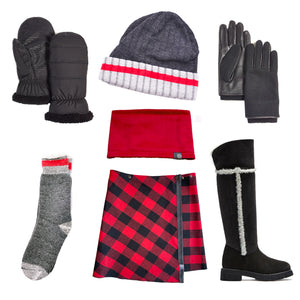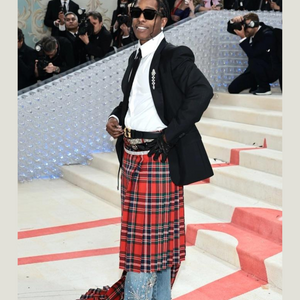The skirt through time
A history of skirt
The skirt has been worn since the beginning of time and not only by women. It is a simple way to cover up, to feel safe and warm. It allows ample movement according to the cut but above all, it is much easier to make than trousers for example. We had fun revisiting the times when we wore the skirt as to understand its origin, its utility but also why we like so much our TUKUAN versatile overskirt.
The Sone Age

It all starts in the Stone Age. Animal furs and hides made up the chief garments during the European Stone Age. They would be held to the body by a thong belt and by pins at the shoulder. Later such skins were pierced with awls and sewn together with cordage to give a closer fit.
A different type of dress was worn by the nomadic peoples who lived on the Steppe, a grassy plain that stretches from Hungary to Manchuria. Such groups, which included the Scythians, Cimmerians, and Sarmatians, traveled immense distances on horseback. Their attire being suited to their way of life, both sexes wore similar garments consisting of a woolen tunic over a shirt and wide trousers. These garments were worn in layers one on top of another; they were fairly close-fitting but loose enough for comfort and for the practical needs of hours spent on horseback.
the Greco-Romans
When we think of the skirt, the image of the Greeks and Romans comes to mind. Indeed, men and women, rich and poor, wore skirts. Why not the trousers that existed back then? According to some sources, there were sociological implications with wearing pants. It was worn by mounted barbarian tribes like the Thracians, Phrygians, Scythians. The Greeks & Romans simply abhorred wearing pants. So they wore tunics, pull over woven tops. Working class or slaves wore shorter tunics with short or no sleeves. Upper-classes wore ankle length & long sleeved tunics.
The Romans inherited many ideas from the Greeks, but, as the empire extended its borders and incorporated peoples of different customs, climates, and religions, matters of style became more complex. In costume, as in art, the trend was toward a more ornate, richly coloured, more varied, and, especially in the later days of the empire, very luxurious attire. Roman dress also reflected a distinct division of social class, with certain colours, fabrics, and styles reserved for citizens and important personages.
With the expansion of the empire, wider trading was made possible. This increased the availability of more varied and elegant fabrics. Cotton from India and silks from East Asia were accessible to the wealthy, enriched by high-quality embroidered edging and fringing.
The garment for which Rome is most famous is the toga. A large piece of material wrapped around the masculine body as a cloak, the toga served a similar function as the Greek himation (sleeveless garments for men and women, wrapped or draped around the body in a variety of ways), although the fabric was of quite a different shape. Under the empire, the toga acquired a special distinction because of its unique and complex method of draping and because, as a note of rank, its wearing was restricted to Roman citizens. The toga was not rectangular in shape like the himation but was a segment of a circle, measuring about 18 feet (5.5 metres) along the chord of the segment and about 5.5 feet (1.7 metres) at its widest point. It was made of wool and so was very heavy. To drape it, about five feet of the straight edge of the fabric was placed against the centre front of the body from ground level upward. The rest of the material was then thrown over the left shoulder and passed around the back, under the right arm, and once again over the left shoulder and arm. The right arm was therefore left free. The material could be pouched in front as well as drawn up over the head. Certain patterns and colours were worn by specific members of society.
Roman influence on the dress of the northern and western countries of the empire was strong until the early 5th century CE. This was to a certain extent, however, a two-way influence since, in the colder northern areas, the Romans found the indigenous dress styles of belted tunics with trousers or leg-banding more suitable than their own Classical tunica and bare legs.
https://www.britannica.com/topic/dress-clothing/Colonial-America
Meanwhile in America
At the time of their first encounter with European explorers, the American Indian population was composed of societies of many levels of social and economic complexity. Cultural groups extended from the Inuit and Yupik/Yupiit of the Arctic circle to the Maya, Aztec, and Inca of Central and South America. With such immense climatic variation, the Americas were home to a wide variety of dress.
The California Indians and the Northwest Coast Indians also wove capes from plant fibres.
Most people wore clothing made from the tanned or chamois skins of local animals, such as deer, elk, buffalo, moose, beaver, otter, wolf, fox, and squirrel. Native Americans employed animal oils, particularly those found in the brains of the animal, to produce a softly textured material that they then dyed in brilliant colours. They often made use of the entire skin, adapting the garment to the shape of the animal and wearing it draped and sewn only minimally.
Depending upon local conditions, men might wear a breechclout or short wrap-skirt and women a short skirt. In warm, dry climates shirts were often optional, while in wetter regions a cloak or poncho might be added. In cooler areas men typically wore a loose hip-length tunic worn on top of thigh-length leggings, the latter tied to the waistband of the breechclout. Women typically wore a long dress on top of short leggings. https://www.britannica.com/topic/dress-clothing/The-pre-Columbian-Americas
Egypt
In Egypt, from about 2130 BC during the Old Kingdom, garments were simple. The men wore wrap around skirts known as the shendyt, which were belted at the waist, sometimes pleated or gathered in the front. During this time, men's skirts were short and wrap-skirts. As the Middle Kingdom of Egypt (1600 BC), came, the skirt was worn longer.
During the Old, Middle and New Kingdom, ancient Egyptian women mostly wore a simple sheath dress called a kalasiris. Women's clothing in ancient Egypt was more conservative than men's clothing.
The Gaelic Kilt
kilt is a type of knee-length skirt with pleats at the back, originating in the traditional dress of Gaelic men and boys in the Scottish Highlands. It is first recorded in the 16th century as the great kilt, a full-length garment whose upper half could be worn as a cloak. The small kilt or modern kilt emerged in the 18th Century, and is essentially the bottom half of the great kilt. Since the 19th century, it has become associated with the wider culture of Scotland, and more broadly with Gaelic or Celtic heritage. It is most often made of woollen cloth in a tartan pattern.
The kilt first appeared as the great kilt, or belted plaid, during the 16th century, and is Gaelic in origin. The great kilt was a full-length garment whose upper half could be worn as a cloak draped over the shoulder, or brought up over the head. A version of the philibeg, or small kilt (also known as the walking kilt), similar to the modern kilt was invented by an English Quaker from Lancashire named Thomas Rawlinson some time in the 1720s. He felt that the belted plaid was "cumbrous and unwieldy", and his solution was to separate the skirt and convert it into a distinct garment with pleats already sewn, which he himself began wearing. His associate, Iain MacDonnell, chief of the MacDonnells of Inverness, also began wearing it, and when clansmen employed in logging, charcoal manufacture and iron smelting saw their chief wearing the new apparel, they soon followed suit. From there its use spread "in the shortest space" amongst the Highlanders, and even amongst some of the Northern Lowlanders. It has been suggested there is evidence that the philibeg with unsewn pleats was worn from the 1690s.
The skirt in the modern time
In modern time, the skirt is typically worn by females. Maxi skirt, midi skirt, mini skirt, calf length, ankle length, ballerina length; leather, lace, corduroy, needlecord, silk, stain, sateen, denim, linen; pencil, flounced, full, gathered, A-line, pleated: women vintage skirts come in every length, fabric, style and colour you can imagine.
Around the turn of the 19th and 20th Century skirts were as long as they could be without actually dragging on the ground. Well, sometimes they actually did – even for daywear, dresses at the time were occasionally worn with a train.

By the 1910s, skirts got a tiny bit more practical and were often more ankle length.
it’s quite a shock to see how much hemlines came up in the 1920s. Day skirts were calf length, and some evening skirt knee length. They were worn without corsets, for an unprecedented freedom of movement for women.
The 80s saw skirts ranging from pencil skirts in primary colours to go with power suits to romantic flounces on long skirts, to short denim skirts and just about everything else.
And the 90s gave us grunge with babydoll dresses, mini kilts, and rave fashions with tiny skirts with psychedelic prints. Womens vintage skirts from the 50s and 60s were very popular in this decade.
https://www.blue17.co.uk/vintage-blog/womens-vintage-skirts/
We hope you enjoyed this skirt fashion journey throughout time. Let us know what you think about it!





